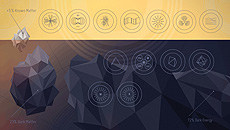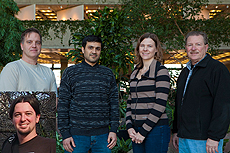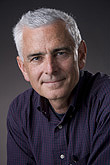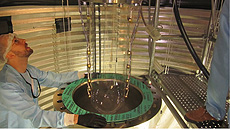Have a safe day!
Wednesday, Jan. 30
3:30 p.m.
DIRECTOR'S COFFEE BREAK - 2nd Flr X-Over
4 p.m.
Fermilab Colloquium - One West
Speaker: Ruben Juanes, Massachusetts Institute of Technology
Title: The Lifetime of Carbon Capture and Storage as a Climate-Change Mitigation Technology
Thursday, Jan. 31
2:30 p.m.
Theoretical Physics Seminar - Curia II
Speaker: Lance Dixon, SLAC/Stanford
Title: Scattering in N=4 Super-Yang-Mills Theory and the Multi-Regge Limit
3:30 p.m.
DIRECTOR'S COFFEE BREAK - 2nd Flr X-Over
THERE WILL BE NO ACCELERATOR PHYSICS AND TECHNOLOGY SEMINAR TODAY
Click here for NALCAL,
a weekly calendar with links to additional information.
Ongoing and upcoming conferences at Fermilab
|
|
Wednesday, Jan. 30
- Breakfast: breakfast pizza
- Tomato florentine soup
- Ranch house steak sandwich
- Italian lasagna
- Smart cuisine: Thai peanut chicken
- California club
- Assorted calzones
- Chicken carbonara
Wilson Hall Cafe Menu |
|
Wednesday, Jan. 30
Lunch
- Chicken satay with peanut sauce
- Pea pods
- Jasmine rice
- Coconut flan
Friday, Feb. 1
Dinner
Closed
Chez Leon Menu
Call x3524 to make your reservation.
|
|
Illuminating the dark universe
 |
The pursuit of dark matter and dark energy is one of the most exciting—and most challenging—areas of science. Now researchers think they're beginning to close in. Image: Sandbox Studio |
If you could use only 5 percent of the alphabet, you'd be stuck with the letter A. Five percent of a complete daily diet is a slice of dry toast.
Yet that's all we have, or at least all we can perceive, of the place we call home.
Less than 5 percent of the universe is ordinary matter made of quarks, electrons and neutrinos.
The rest is dark matter (23 percent) and dark energy (72 percent). They have nothing in common, it seems, except our inability to see them directly with the tools we have at hand and their profound influence on the visible universe.
Like explorers at the brink of any new frontier, we want to know more. We want to know why galaxies hold together rather than fly apart, why the universe is expanding faster and faster, and how a shadow world of unseen, unexpected particles and/or forces and/or things we can't even imagine yet could intertwine with our own.
We want to know what this dark stuff is.
In hot pursuit
The pursuit of dark matter and dark energy is one of the most exciting challenges in physics, and it's being carried out on nearly every conceivable front: deep underground and far out in space, on the vast scale of the cosmos and the infinitesimally tiny scale of subatomic particles, with sound waves from the big bang and the brilliant remains of exploding stars.
Although years of research have yet to reveal the nature of dark matter and dark energy, few scientists doubt they exist; their distinctive fingerprints are all over the cosmos, shaping the growth and evolution of the large-scale structures, such as galactic filaments and clusters, we see today.
Now scientists think they're beginning to close in.
Theory, observations and sophisticated computer simulations are converging on candidate particles and promising techniques that seem likely, at last, to tell us what dark matter is made of.
"You should be able to see actual dark matter particles just beyond where the current generation of experiments is," says Glen Crawford, director of the Research and Technology Division of the Office of High Energy Physics at the U.S. Department of Energy, which is a major funder of dark universe projects. "People have been coming up with clever new ways of doing these dark matter experiments."
As for dark energy, scientists know almost nothing about it at all. But over the next 10 to 15 years, projects now planned or under way will map out the growth and evolution of the universe ever more precisely and further back in time, refining key measurements that offer strong clues to what dark energy is.
Read more
—Glennda Chui
|
Tuition Assistance Program degree recipients
 |
Five Fermilab employees recently received degrees through the Tuition Assistance Program. From left: Mark Dilday, AD, B.S. in electronics engineering technology; Salman Tariq, AD, M.S. in engineering management; Amber Kenney, ESH&Q, M.S. in industrial technology; Donald Arnold, TD, B.S. in industrial technology and management. Inset: Joshua O'Connell, AD, B.S. in information technology and management, summa cum laude. Photo: Cindy Arnold; inset photo courtesy of Karen Karlix-Smith |
|
University of Iowa
NAME:
University of Iowa
HOME TOWN:
Iowa City, Iowa
MASCOT:
Hawkeyes
COLORS:
Black and gold
COLLABORATING AT FERMILAB SINCE:
1986
WORLDWIDE PARTICLE PHYSICS COLLABORATIONS:
ATLAS (CERN), CALICE, CDF, CMS, ILC R&D, MICE (STFC), MIPP
NUMBER OF SCIENTISTS AND STUDENTS INVOLVED:
Seven faculty, three research scientists, six postdocs, about 15 graduate students, eight undergraduate students
PARTICLE PHYSICS RESEARCH FOCUS:
Our group focuses on both the Energy and Intensity Frontier (ZEUS, BABAR,
ATLAS, CMS, ILC, Fermilab experiments CDF, MIPP, E683, E781). Our
experimental effort ranges from detector R&D to discovery physics
analysis. It includes construction of detectors for use in Fermilab fixed-target experiments as well as large-scale detector efforts such as the
design, construction, installation and commissioning of the CMS
hadronic forward calorimeter. We have several group members
stationed at Fermilab to participate in the Fermilab LPC and in
test beams for detector development. We also collaborate with Fermilab
theorists. Our analysis interests range from precision tests of the
Standard Model to searches for beyond-the-Standard Model physics. We do theoretical work in string theory, specifically gauge-gravity duality and dark matter and dark energy, and 2+1 Yang-Mills and Chern-Simons theory.
WHAT SETS PARTICLE PHYSICS AT IOWA APART?:
We are unique in the long history and extent of our involvement at Fermilab and in the diversity of our program even though we are a small group. We have been active at Fermilab since the mid-1980s in fixed-target experiments and test beams. Our graduate students and postdocs are in residence at the Fermilab LPC; theory graduate students also spend significant time at Fermilab. Group members who don't live at Fermilab commute often in order to work at the LPC, test beams and other collaborative efforts. We have a long history of building detectors at Fermilab: E704 CNI polarimeter, E781 tracking chambers, E761 silicon detectors and MIPP tracking chambers. More recently we worked with Fermilab scientists and engineers (and other U.S. and worldwide collaborators) on the CMS hadronic forward calorimeter and ILC R&D. Our test beam work includes ZEUS calorimeter tests in the 1990s, CMS and the ILC. Our group greatly benefits from the resources at Fermilab for detector development, physics analysis and theory collaboration. We are a QuarkNet institution.
FUNDING AGENCIES:
DOE, NSF
View all university profiles.
|
|
Break out the bubbly
 |
|
Craig Hogan
|
Craig Hogan, head of the Center for Particle Astrophysics, wrote this column.
If you hung around the Wilson Hall café at Friday lunch in recent years, you might have noticed a conspicuous group of men, well-dressed in dark suits and ties, and sometimes wearing dark shades. They're not prohibition-era gangsters—no, these are the young scientists of the Chicagoland Observatory for Underground Particle Physics, or COUPP, strutting their stuff.
But you haven't seen them lately, because they have literally gone underground—more than a mile underground, in a laboratory, deep in a Canadian nickel mine. They have fled there not to escape the long arm of the law, but to take shelter from the relentless cosmic rays that rain down on the surface of the earth from outer space and to start up a new particle detector.
Our Pierre Auger Observatory scientists built detectors in the Argentinian pampa and are eager to catch and study as many cosmic-ray particles as they can at the highest energies they can find. So why do our COUPP scientists flee to the depths of the earth to get away from these naturally occurring particles?
They are there, a mile underground at SNOLAB, to seek the most exotic cosmic particles of all: the constituents of the famous dark matter that swarms throughout the space of our galaxy and throughout the universe. Unlike cosmic rays, these particles hardly interact with matter at all, and go right through the earth. Very rarely, perhaps once a year in a handful of material, one of the dark-matter particles will hit an atomic nucleus and make it gently recoil. That's the quest of the COUPP posse: they want to find a kind of particle that's never been detected before.
The COUPP experiment looks like a bootlegger's still, but it is actually a modern version of a type of particle detector that Fermilab used with accelerator experiments for many years: a bubble chamber. An atom recoiling from a dark-matter collision makes a little bubble in a vessel that looks like a giant test tube, filled with 60 kilograms of superheated liquid. The device records the sound this collision creates and takes pictures of the bubble as it grows. (In the '70s and '80s, experiments used giant movie cameras to record the tiny bubbles that formed the tracks of charged particles. The biggest bubble chamber ever used at Fermilab is on proud display outside our Silicon Detector Lab, 15 feet wide and complete with its 70-mm cameras.)
In the last few months, the COUPP team members have shed their cool black suits for safety helmets and white bunny suits and spent months in a deep underground cleanroom assembling their apparatus. Last week, they installed the last major pieces of their machine. Now they are ready to start filling it to see what kind of new particle bubbles up. Stay tuned!
 |
Fermilab Lederman Fellow Hugh Lippincott observes the lowering of the inner vessel of the COUPP 60-kg chamber into position at SNOLAB, a laboratory deep underground in Ontario, Canada. Photo: Eric Vazquez Jauregui |
|
ESH&Q weekly report, Jan. 29
This week's safety report, compiled by the Fermilab ESH&Q section, contains five incidents.
A subcontract employee struck his thumb with a hammer, resulting in medical treatment.
A subcontract employee cut his hand with a utility knife, resulting in medical treatment.
A subcontract employee slipped on ice, but did not require treatment.
An employee felt back pain after moving concrete blocks. He received first-aid treatment.
An employee slipped on ice. He received first-aid treatment.
Find the full report here. |
Farewell to the researcher Aldo Menzione
From Il Tirreno - Pisa, Dec. 24, 2012
Editor's note: The following is a translation by Fermilab scientist Luciano Ristori of an article that appeared in the Italian-language newspaper Il Tirreno - Pisa, published with permission. You can read more about former Fermilab user Menzione and his work in this Physics Today article by Giorgio Bellettini and Henry Frisch.
The scientific community is in grief. Aldo Menzione, internationally renowned and esteemed scientist, suddenly passed away on Dec. 23.
Menzione was born in Massa, Italy, in 1943 and received his degree in physics in Pisa.
He was always involved in advanced research in laboratories around the world. He was involved in the Framm experiment (1973-1980) at CERN to measure the lifetime of the charm quark and the Clue experiment to find a new technique to detect showers produced by cosmic rays in the atmosphere through Cherenkov light. Beginning in 1980 he was involved the CDF experiment in Fermilab (Chicago), which led, thanks to Aldo Menzione's fundamental contribution, to the design and construction of the first silicon tracker, which made possible the 1995 discovery of the top quark and opened new ways for the physics of very high-energy hadronic collisions.
Read the entire translated article
Read the original article (in Italian) |
|